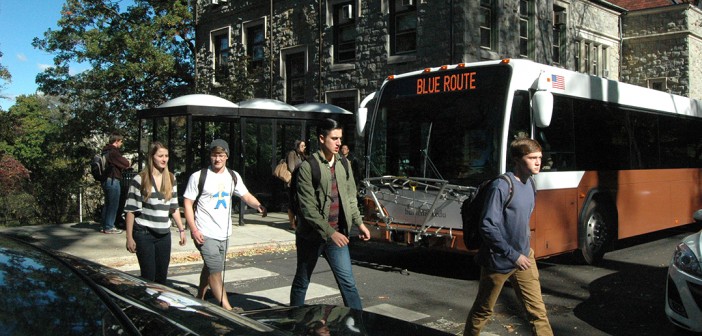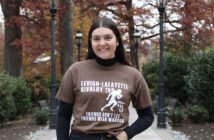In a response to overcrowding on the Mountaintop-bound buses, Lehigh’s Transportation Services plans to add a new route to the current bus system.
The route, which is included in the master plan as the “Packer Express,” will run about every 10 minutes and just make stops on lower campus. The Mountaintop route will continue along its normal route, but the Packer Express will serve residents of “the Hill” and take some of the pressure off of the Mountaintop services. With this new route in place, Mountaintop buses will start to run every 15 minutes, instead of 10 on the current schedule.
Robert Bruneio understands student concerns involving campus transportation options. As the manager of transportation services, part of his job is to oversee all four transportation routes.
Bruneio made it clear that his foremost goal is to provide students with a safe and convenient way to get around campus.
The Mountaintop route has two main buses that can hold up to 95 students each. The buses that are in place now are much bigger than the original buses, which can only hold about 48 students.
“(The) Mountaintop (bus) is the most popular,” Bruneio said. “With the bigger buses, we are generating more ridership — that has certainly increased and improved.”
Bruneio said he could not give an exact date of when the plan will be implemented, but Transportation Services has it planned for the near future.
“We are looking into moving the bus wait time to 15 minutes to accommodate, because 10 minutes is stretching it,” Bruneio said. “We have had an increase in traffic, pedestrians and construction, so our buses are barely making that 10 minute (time frame).”
Heidi Cacciola, ’15, rides the Mountaintop bus to the Packer Avenue stop. As a commuter student, Cacciola has no other option but to ride the bus up to her car.
“Every day, it is overcrowded,” Cacciola said. “(The times) it is most crowded (are) noon and 4 p.m. It’s just really annoying. I have to use the bus system to get to my car versus (the) people that don’t want to walk somewhere.”
Kaitlin Fisher, ’14, ‘15G, has a different opinion on the bus system. She rides the bus most days to Mountaintop and usually departs at the Packer stop. While she said that the bus is usually full midday, the crowd tends to thin out once the bus stops at the various sorority and fraternity houses.
“Another bus sounds nice, but I think it (would) be a little excessive,” Fisher said. “I have built taking the bus into my schedule.”
The Take a Ride Around Campus Safely service is a late-night transportation option for student riders. The difference with the TRACS route compared to others is that it has stops at Montclair Avenue and East Fifth Street.
The TRACS system was put in place to prevent students from having to walk to their on- or off-campus residences at night. The TRACS van fits 15 people, but often does not have enough room to accommodate the student demand at particular times and stops.
“When you have 30, 40, 50 (students) that want to ride up ‘the Hill’ instead of walk it kind of takes away from the safety aspect,” Bruneio said. “We have (students) that want to use it for the convenience aspect of it rather than the safety aspect.”
Bruneio said there are plans to add another TRACS van or bus, but it will take time. The drivers who drive the Mountaintop route hold a commercial driver’s license, which permits them to drive a bus. The TRACS drivers are not governed by the same regulations. If the TRACS service does expand to use a bus in place of the vans, it would require the university to either hire new staff who hold the appropriate license or have current TRACS drivers acquire it.
“The (drivers) are really concerned for the safety of the students,” Bruneio said. “They do care about the students. I have heard very few complaints about the Mountaintop bus drivers. The bus drivers know the students, and the students know the drivers.”
According to Bruneio, one item that would benefit students is having covered bus stops at all locations, including the TRACS stops and Williams Hall. This addition, he said, is also in the master plan.
Bruneio encourages students to come and see him with problems they might have with transportation services.
“I am very transparent,” Bruneio said. “I can’t fix it if I don’t know it’s broken. I may not have an answer for your legitimate concerns, but I will certainly do my best to try.”
Parking Services office shares the goal to support students as best as it can.
Assistant Manager Brett Johnson knows the most common problem students with cars face is the amount of parking that is available. His position entails overseeing the enforcement officers and making sure the parking on campus runs as smoothly as possible.
This year, 1,897 parking permits were distributed to students. During normal parking hours between 6 a.m. and 4 p.m., there are 1,737 spaces that are available to students. After 4 p.m. when the reserved parking restrictions are lifted, except for medical and handicap spaces, the number rises to 3,552 spaces.
Johnson said even with the 3,552 spots being filled completely, there are still some spaces that are available for parking.
“We have to accommodate for fluctuations,” Johnson said. “Especially when visitors are coming in. (Some spots) for admissions might not be used daily, but it is still used regularly enough that it warrants a space being reserved for.”
Johnson also acknowledged that meter parking is another issue. Students may not fully understand what each meter color stands for. The biggest difference with the meters on campus is they are not available to all students, which results in tickets being issued.
Johnson said there are 169 meters on campus, which does not include the blue meters, which are handicap spaces. The brown meters are for visitors, faculty and staff. Students who park at these meters can receive up to three parking citations during the time they are parked in the space. The first and second citation come from having a permit and not parking in the designated spot in which the permit is valid. The third one primarily gets issued when the meter has expired.
The gold meters are the most versatile, as students are permitted to park at them at any time. These meters allows the students the longest amount of parking time, according to Johnson.
For students who drive to campus, the most efficient place to park is the Zoellner Arts Center garage. The garage is open until 11 p.m., and students can either pay the $4-a-day fee, or purchase the permit to park in the garage.
The student would also need to purchase two parking permits: one for the garage and another for their residence hall parking lot.
“I think the biggest thing is that if (students) are ever unsure about where to park, or at what time (they) can always email or call us,” Johnson said. “We will definitely let you know about what works.”
As the semesters go by, Parking and Transportation Services will hear new student complaints and suggestions. The managers will take into account what the student needs and wants are and try to make the necessary changes to make getting around campus easier.






Comment policy
Comments posted to The Brown and White website are reviewed by a moderator before being approved. Incendiary speech or harassing language, including comments targeted at individuals, may be deemed unacceptable and not published. Spam and other soliciting will also be declined.
The Brown and White also reserves the right to not publish entirely anonymous comments.
1 Comment
It’s Packer Ave, not Packard, and Asa Packer Campus that the new route would be running, so are we sure that this new route won’t be called the PACKER Express?